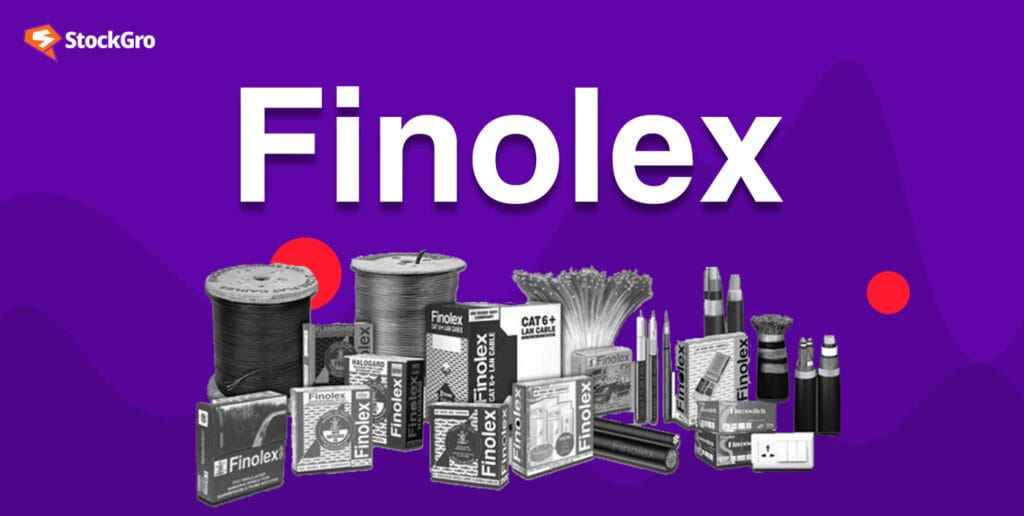
As one of India’s leading electric cable manufacturers since 1958, Finolex Cables has seen the industry transform over the past six decades. As rapid infrastructural upgrades and 5G rollouts drive demand for optical fibre cables (OFC), Finolex aims to expand into this high-potential segment.
With a planned ₹580 crore OFC facility in Maharashtra, this blog examines listed cable player Finolex’s market position, financial health, growth strategies, and future outlook amidst rising opportunities. Read on for an in-depth analysis of this legacy cable company’s changing course.
Evolution of Finolex Cables Ltd.
Finolex comes from the combination of “fine” and “flexible,” apparently because the company’s first product, flexible wires, was made with refined copper.
Pralhad P. Chhabria and Kishan P. Chhabria established Finolex in 1958. In the beginning, the company made copper cables. However, the founders showed great vision by branching out into making PVC-insulated electrical cables for the automobile sector.
During its remarkable sixty-year history, the company has established itself as a leader in innovation and a model of excellence in manufacturing.
With expectations for further development of construction activity, the electrical cable market saw an 8% gain in sales volumes. When it comes to volume, Finolex Industries is projecting double-digit growth for FY24.
Also read: What does the EV boom mean for auto stocks?
Finolex Cables news: ₹580 crore optic fibre project in Maharashtra
A MoU was recently formed between the company and the Government of Maharashtra’s Department of Industries. Finolex Cables is planning to expand its presence in the optic fibre cable business, and this strategic alliance paves the way for the organisation to spend ₹580 crore in the process.
According to Finolex Cables, the spending is in line with Prime Minister Narendra Modi’s plan to connect every town with last-mile optical cable. With the statewide roll-out of 5G and the increasing need for fibre-to-home connections, the business is predicting a spike in demand.
At present, Finolex Cables can draw 40 lakh fibre km per year and cable 80 lakh fibre km annually. As part of this growth plan, they will be installing fibre draw towers and using backward integration to make glass pre-forms, which are an integral part of the fibre drawing procedure.
As a result, Finolex Cables will join an exclusive group of domestic manufacturers of glass preforms, an essential raw material for optical fibres.
The existing capacity of the fibre optic cables is 4 million km/year; with the planned expansion, it will increase to 10 million km/year, and the draw tower capacity will double to 8 million km/year.
Finolex Cables competitors
Some of the competitors of Finolex Cables as of February 23, 2024, ranked by market capitalisation (₹ cr.), are:
- Polycab India Ltd. (72,121.76)
- KEI Industries Ltd. (28,514.49)
- R R Kabel Ltd. (16,293.29)
Also read: Union Bank of India raises ₹3,000 crore through QIP, stock price soars 7%
Finolex Cables Financials
As of February 23, 2024, 3:59 PM IST, Finolex Cables’ share price was ₹980.80. Considering the Finolex Cables price history, the previous share price was ₹988.05. Finolex Cables’ share price was down by 0.15%. Within the past month, Finolex Cables’ share price has dropped by 9.19%.
| Metric | Value |
| Market capitalisation (₹ Cr.) | 15,000 |
| Book value per share (₹) | 285.76 |
| Dividend Yield | 0.71 |
| ROCE | 18.5 % |
| ROE | 11.53% |
| Face value (₹) | 2 |
Investing in Finolex Cables
Pros
- Stable risk rating for the business
Finolex has a significant presence in the market, and to expand its reach from 90,000 to 3 lakh shops, FCL has designed approximately 3 lakh stores. It is safe to assume that in a highly competitive industry, the company’s robust distribution network will boost volume growth throughout the following two fiscals.
Backward integration, which means having copper bars on hand, makes sure that they have a steady supply of high-quality raw materials, and it gives them an edge over small, unorganised competitors.
The fast-moving electric goods (FMEG) category is the latest addition to the company’s product line, and it is projected to reach a value of ₹500 crore in the years to come.
- Expectations for consistent expansion in critical areas:
When it comes to cables, FCL is primarily involved in the electrical and telecom markets. With the Roorkee plant, the electrical cable company could benefit from better accessibility in northern and eastern India. The communication cable market is poised for growth in the short to medium term, thanks to strong demand for 5G service rollouts throughout the nation.
- Excellent financial stability:
With a sufficient net worth of ₹4,599 crore as of September 30, 2023, the financial risk profile should be in good shape. In the fiscal year 2024, debt protection indicators will be satisfactory, with a net cash accrual to total debt ratio and adjusted interest coverage that are both in good shape.
With consistent cash inflows, net worth is expected to increase, and gearing should stay low since investments and increased capacity will be paid for internally. Capital expenditures for the next two fiscal years may be met with an estimated annual net cash accrual of ₹400–550 crore, reducing the need for external borrowing.
Cons
- Exposure to copper price swings:
Copper accounts for more than 75% of the total cost of raw materials required to make cables. Although FCL adjusts cable rates in response to changes in the cost of raw materials, the company has been profitable in recent quarters despite its incapacity or delay in passing the price increase on to consumers.
- Risk of recession and fierce competition:
The possibility of a domestic economic downturn will continue to put FCL at risk. Approximately eighty per cent of sales come from electrical cables, which include applications in construction, agricultural activities, and automotive sectors.
The general economy is a crucial indicator of these industries’ growth. The real estate market may be affected by low GDP growth, which could lead to less demand for electricity lines.
Also, the fact that there are a lot of established players and unorganised businesses in the electrical cable market makes it harder for organised players to set prices. The local market is becoming more quality-aware, but there is a lot of competition, which could make it harder to generate revenue.
- Small-scale electrical appliance operations:
Products offered by FCL’s recent entry into the electrical appliance market include fans, switches, switch gears, LED lights, and more. The product line is anticipated to break even at roughly ₹200 crore, while the revenue contribution of this sector stays inadequate at ₹195 crore in fiscal 2023.
Also read: Sugar stocks sour as government raises fair price to ₹340/quintal
Shareholding pattern of Finolex Cables
The shareholding pattern (as of December 2023) of Finolex Cables is as follows:
Promoters: 35.92%
Foreign Institutional Investors (FIIs): 11.06%
Domestic Institutional Investors (DIIs): 15.94%
Public: 37.08%
Conclusion
Finolex Cables has a firm place in the electric wire market thanks to its extensive distribution network and integrated facilities. Despite being vulnerable to changes in copper prices and the risk of a slowdown, its growing focus on high-potential optical fibre lines opens up new opportunities in a highly competitive sector.

